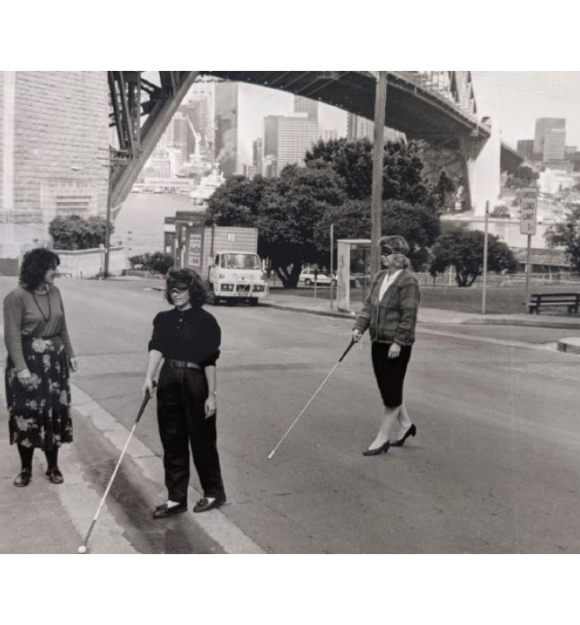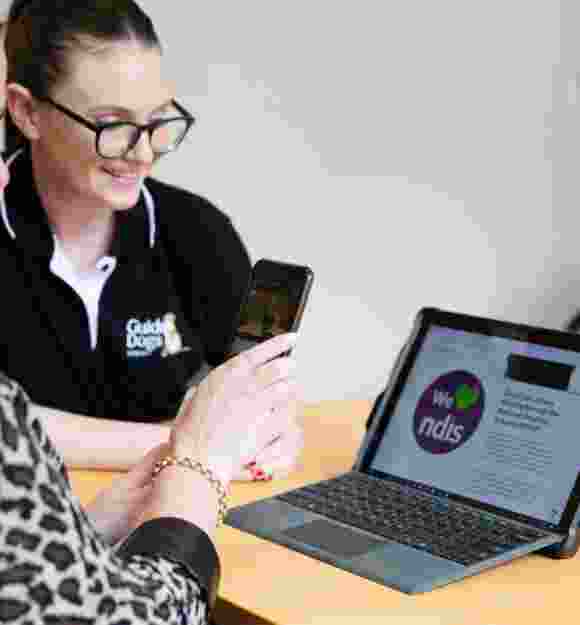Our heritage shows us anything is possible.
The history of Guide Dogs is one of contrasts. It’s about courage, hard work and tenacity. It’s also about care, attention and support. We’re proud of our past, but even more excited about what we can achieve in the future.
The arrival of Guide Dogs
Australia’s first-ever Guide Dog was Dreena, brought to Australia from London in 1950 by Western Australian Harvard graduate and economics lecturer Dr Arnold Cook.
Did you know?
Guide Dogs NSW/ACT has always advocated for the rights of our Clients and the dogs that support many of them. In 1962 it became legal for Guide Dogs to fly domestically.

We walk alongside
Quality training and guidance has always been core to our service — with Clients, families, dogs and our own staff. Here, pictured above, Orientation and Mobility Instructors gain hands-on experience using canes in 1989.
A lifetime of service
Guide Dogs NSW/ACT was founded by Doug Cameron in 1957. As a past Board Member, volunteer and current major donor and benefactor, Doug continues to actively support the work of our organisation.
We are more than dogs, but they always spark our passion.
At Guide Dogs, we offer so much more than dogs. But these wonderful animals are embedded in the DNA of everything we do. They’ve connected us with volunteers, supported our Clients, and steered our very thinking on what else we can provide when they might not be the right solution for a person’s circumstances.
A true centre of excellence
Built more than 20 years ago, the Glossodia Guide Dog Centre continues to support the training and welfare of our dogs and the needs of our staff.

Collecting quite a reputation
Guide Dogs’ Collection Dogs have been a familiar sight across the nation since the 1970s, raising awareness of the movement and valuable funds for our vital work.
Did you know?
It costs more than $50,000 to breed, raise, train and support a Guide Dog across its working life.
Everything we do is to help people shine.
From our first Guide Dog to the best in early detection, our services have evolved and expanded as we find new ways to support and increase the independence of the people we support. From assessment to ongoing support, our Clients goals are always at the centre of what we do.
Supporting active living
Guide Dogs NSW/ACT’s popular Orientation and Mobility Services help Clients live active and independent lives.

Helping prevent low vision and blindness
The Centre for Eye Health began operating in 2009 and now helps more than 12,000 people a year with detection, diagnosis and management advice.
Technology is changing how we all live and work.
Rapid advances in technology in the past twenty years have transformed the way people with low vision or blindness live, work and play. From hand-held Miniguides to the smartphone, each new innovation opens up exciting new possibilities. Who knows what future technologies might hold for us all?

Supporting Australian innovation
The Miniguide was invented in Australia and developed with the assistance of Guide Dogs NSW/ACT. The first units were purchased in 2001 and it remains a valuable secondary mobility aid for cane users or Guide Dog Handlers.
Need technology advice?
Guide Dogs NSW/ACT established a dedicated Assistive Technology Help Desk in 2020 to support any Client needing help with their existing devices or wanting advice about newly available technologies and applications. Call 1800 484 333.
